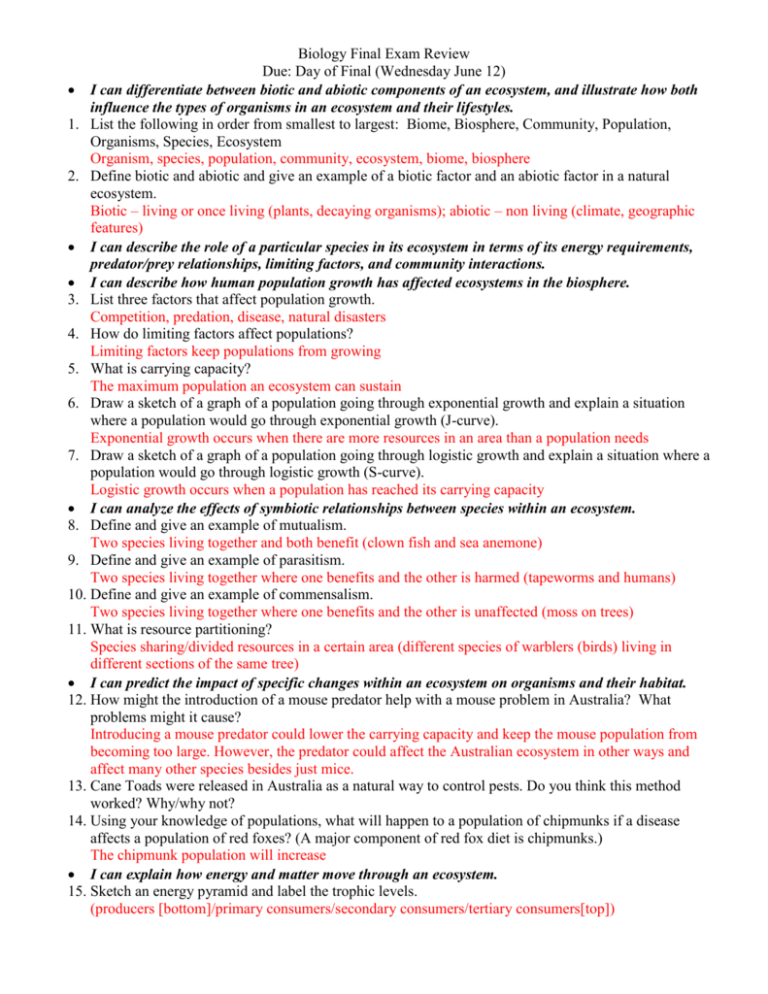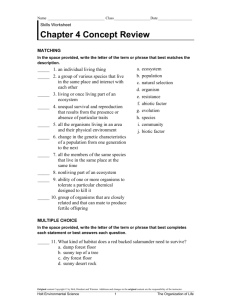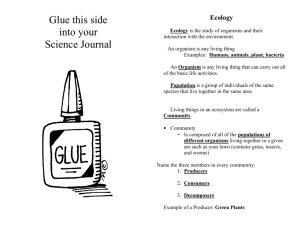Biology Final Exam Review Due: Day of Final (Wednesday June 12
advertisement

Biology Final Exam Review Due: Day of Final (Wednesday June 12) I can differentiate between biotic and abiotic components of an ecosystem, and illustrate how both influence the types of organisms in an ecosystem and their lifestyles. 1. List the following in order from smallest to largest: Biome, Biosphere, Community, Population, Organisms, Species, Ecosystem Organism, species, population, community, ecosystem, biome, biosphere 2. Define biotic and abiotic and give an example of a biotic factor and an abiotic factor in a natural ecosystem. Biotic – living or once living (plants, decaying organisms); abiotic – non living (climate, geographic features) I can describe the role of a particular species in its ecosystem in terms of its energy requirements, predator/prey relationships, limiting factors, and community interactions. I can describe how human population growth has affected ecosystems in the biosphere. 3. List three factors that affect population growth. Competition, predation, disease, natural disasters 4. How do limiting factors affect populations? Limiting factors keep populations from growing 5. What is carrying capacity? The maximum population an ecosystem can sustain 6. Draw a sketch of a graph of a population going through exponential growth and explain a situation where a population would go through exponential growth (J-curve). Exponential growth occurs when there are more resources in an area than a population needs 7. Draw a sketch of a graph of a population going through logistic growth and explain a situation where a population would go through logistic growth (S-curve). Logistic growth occurs when a population has reached its carrying capacity I can analyze the effects of symbiotic relationships between species within an ecosystem. 8. Define and give an example of mutualism. Two species living together and both benefit (clown fish and sea anemone) 9. Define and give an example of parasitism. Two species living together where one benefits and the other is harmed (tapeworms and humans) 10. Define and give an example of commensalism. Two species living together where one benefits and the other is unaffected (moss on trees) 11. What is resource partitioning? Species sharing/divided resources in a certain area (different species of warblers (birds) living in different sections of the same tree) I can predict the impact of specific changes within an ecosystem on organisms and their habitat. 12. How might the introduction of a mouse predator help with a mouse problem in Australia? What problems might it cause? Introducing a mouse predator could lower the carrying capacity and keep the mouse population from becoming too large. However, the predator could affect the Australian ecosystem in other ways and affect many other species besides just mice. 13. Cane Toads were released in Australia as a natural way to control pests. Do you think this method worked? Why/why not? 14. Using your knowledge of populations, what will happen to a population of chipmunks if a disease affects a population of red foxes? (A major component of red fox diet is chipmunks.) The chipmunk population will increase I can explain how energy and matter move through an ecosystem. 15. Sketch an energy pyramid and label the trophic levels. (producers [bottom]/primary consumers/secondary consumers/tertiary consumers[top]) 16. The largest amount of biomass will be found in which trophic level? (In order for a functional ecosystem, which level must have the most organisms?) Producers 17. How much energy would be transferred from the 1st to 2nd trophic level in a typical community? 10% 18. What are the two main processes of the carbon cycle? Photosynthesis and respiration 19. In the nitrogen cycle, which organisms are essential in converting nitrogen to a form plants can use? Bacteria 20. How does energy move through a food pyramid? How does it get recycled? Energy moves in one direction through a food pyramid (producers consumers). Energy gets recycled by decomposers placing energy and nutrients back in the soil I can construct an accurate food web given organisms and their energy requirements (heterotroph vs. autotroph). 21. What is the difference between a food chain and a food web? A food chain follows one path, a food web shows many organisms with many arrows connecting them 22. What is the original SOURCE of energy in any ecosystem? The sun 23. Give an example of each: carnivore, herbivore, omnivore. Carnivore – eats only meat, tiger Herbivore – eats only plants, bunny Omnivore – eats both meat and plants, humans 24. Which sequence below is the best representation of a food chain? a. Rabbit ->Bacteria -> Grass -> Lynx b. Lynx -> Grass -> Bacteria -> Rabbit c. Grass -> Rabbit -> Lynx -> Bacteria d. Bacteria -> Lynx -> Rabbit -> Grass 25. Diagram a four-organism food chain that includes you. Label each organism as a producer or primary, secondary, or tertiary consumer. Grass (producer) cow (primary consumer) human (secondary consumer) fungi (tertiary consumer/decomposer) I can restate Darwin’s Postulates for Natural Selection 26. What are Darwin’s four postulates for natural selection? 27. What does “survival of the fittest” mean? That some organisms, due to random mutations, are better suited to live in a particular environment than others. These organisms are more likely to live longer, and therefore more likely to reproduce, so that their mutated (and better adapted) genes will be passed on to future generations. 28. What will happen to organisms that have a variation or mutation that gives than an advantage in a particular ecosystem? These organisms will be more likely to reproduce, so this gene is passed on to more offspring. 29. What is the main way that new genes are introduced into the gene pool? mutation 30. Explain why Darwin’s finches looked dramatically different on each of the Galapagos Islands if they all share a common ancestor from South America. Each of the Galapagos Islands had a slightly different ecosystem, so the finch took different niches on different islands and the finches evolved differently, depending on their location and niche. I can provide an accurate definition for evolution 31. What is evolution? The change of species over time. 32. Recall our lesson on pocket mice. How were the populations of pocket mice affected by a volcanic eruption in certain areas? The population of pocket mice had a random mutation where most were white, but some mice were black. The mice lived on white rocks. After the volcanic eruption, the landscape and rocks they lived on were black. Over time, the population of pocket mice slowly changed so that the majority of mice were black, because they were more camouflaged from predators. 33. What is artificial selection, and give two examples of organisms that humans have affected through artificial selection. Artificial selection is where humans choose desirable traits in organisms and breed them to make a new organism with the desired traits. Examples are many fruits and vegetables (broccoli), cows, and dogs. 34. Explain how evolution relates to the fact that main bacterial diseases such as tuberculosis are becoming harder to cure with antibiotics. Bacteria stains are evolving so that they are unaffected to many antibiotics. We need to be careful to only take antibiotics when completely necessary! I can describe evidence for evolution including: fossils, homologous structures, embryology, and genetics/molecular biology. 35. When analyzing fossils, where (in the layers of rock) are the simplest organisms found? The deepest/oldest layers of rock 36. How are fossils used to explain the evolution of species over time? Comparing older to newer fossils, small changes can be seen. 37. What is a homologous structure? Give an example. Homologous structures are structures that are similar in two different organisms because they evolved from the same common ancestor. Example: bat wing and mole foot 38. What is an analogous structure? Give an example. Analogous structures are structures that have similar functions, but evolved through different paths. Example: bat wing and insect wing 39. At early stages of development, is it easy or difficult to tell the difference between embryos of different vertebrates? Difficult 40. When scientists say, “there is biochemical evidence for evolution,” what do they mean? Organisms that are more related share more of a DNA sequence. I can explain a species distribution using natural selection theory. I can map speciation and establish evolutionary relationships given fossil evidence. 41. What is a species? Organisms that can mate and produce fertile offspring. 42. What is reproductive isolation? Where one species because geographically isolated and evolves differently into two different species that can no longer mate (example: a river separates a population of insects, and they independently evolve on separate sides of the river.) 43. Explain why the statement “humans came from monkeys,” does not properly explain the theory of evolution. Humans and monkeys evolved at the same time into different niches. If humans evolved from monkeys, monkeys would be extinct. I can define classification vocabulary: eukaryotic, prokaryotic, heterotrophic, autotrophic, unicellular, multicellular. 44. Define prokaryotic and give an example of a prokaryotic organism. No nucleus, no organelles, simplest form of life. Must be a singled celled organism. Ex: bacteria 45. Define eukaryotic and give an example of a eukaryotic organism. Cell with nucleus and organelles. May be single or multi celled organism. Ex: protists 46. Define heterotrophic and give an example of a heterotrophic organism. Obtains food from other organisms ex: polar bear 47. Define autotrophic and give an example of an autotrophic organism. Creates its own food. Ex: daisies I can infer an organism’s Kingdom based on its characteristics. 48. For each of the kingdoms (archaebacteria, eubacteria, Protista, fungi, plants, animals), state if they are prokaryotic/eukaryotic, unicellular/multicellular/both, auto/heterotrophic/both, cell walls/no cell walls. Archaebacteria and eubacteria: prokaryotic, unicellular, both auto and heterotrophic, no cell walls Protists: eukaryotic, both uni and multi, both auto and hetero, no cell walls Fungi: eukaryotic, both uni and multi (yeast is uni), hetero, cell walls of chitin 49. To what kingdom do viruses belong? Viruses are NOT living, so they do not belong to a kingdom. 50. What type of virus is specific to bacteria? bacteriophage 51. How do vaccines work? Vaccines prevent viruses from infecting cells, so they can no longer spread/reproduce 52. Describe the differences between the lytic and lysogenic cycles of viruses. Lytic: virus infects cell, reproduces, and kills cell. Lysogenic: virus infects cell, inserts itself into cell DNA, cell divides and passes virus onto offspring. I can correctly order the taxonomic categories from least specific to most specific 53. What is the process of classifying organisms and giving each a scientific name called? taxonomy 54. Place the eight categories of taxonomic classification in order from least to most specific (remember the mnemonic device). Domain, kingdom, phylum, class, order, family, genus, species 55. Binomial nomenclature uses which two taxonomic categories? Genus, species I can infer an organism’s Genus and species based on its scientific name. 56. What two classification categories are used in binomial nomenclature? Genus, species 57. Provide the official name for a honey badger that has the scientific classification: Kingdom – Animalia, phylum – Chordata, class – Mammalia, order – Carnivora, family – Mustelidae, genus – Mellivora, species – Capensis Mellivora capensis I can describe organisms from each Kingdom of Life: Bacteria 58. List the three different shapes of bacteria and the two arrangements they can make. Shapes: cocci, bacilli, spirilla Arrangements: strepto, staphylo 59. What is the scientific name for bacteria that is spherical bacteria arranged in clusters? staphylococci 60. How do antibiotics help fight against bacterial diseases? Antibiotics keep bacteria from reproducing 61. Describe two “good” uses of bacteria and one “bad” use. Bacteria fix nitrogen to be used by plants, bacteria are in yogurt and help us digest food, bacteria can be parasites for animals I can accurately use a dichotomous key to identify an unknown organism. 62. Make a dichotomous key to identify the following leaves at right. I can describe organisms from each Kingdom of Life: Fungi 63. Draw and label a mushroom (hyphae, mycelium, fruiting body) Fruiting body is the part you see as a mushroom, hyphae is a single filament/fiber of mushroom (both above and underground), mycelium is the overall network of all hyphae. 64. List the five phyla of fungus and give an example of each type. Chytridiomycota – water molds, Ascomycota – yeast, sac fungi, zygomycota – bread molds, basidiomycota – club mushrooms, deuteromycota – athlete’s foot, yeast infections 65. What are the two types of symbiotic relationships fungi have? (hint: plants, protists) Lichen (fungi and algae), Mycorrhizae (fungi and plants) 66. What is a saprobe? Organism that gets its energy from decaying matter 67. What is unique about yeast being in the fungus kingdom? It is unicellular I can describe organisms from each Kingdom of Life: Protists 68. How are the three types of protists classified? Plantlike, animall ike, fungus like 69. What are the three ways that protists can move? Draw an example of each. Flagella (tail), cilia (hair), pseudopods (cytoplasm extensions) 70. How do zooflagellates move? flagella 71. What are slime molds? Fungus like protists 72. A protist makes its own food through photosynthesis. What type of protist is it? Plant like 73. A protist is heterotrophic. What type of protist is it? Animal or fungus like I can describe organisms from each Kingdom of Life: Plants 74. Describe the difference between non-vascular plants, vascular plants, gymnosperms, and angiosperms. Non-vascular- must be in water (no vascular system so cannot transport water/nutrients throughout plant), seedless/vascular – seeds, but have a vascular system (ferns, horsetails, club mosses), gymnosperms- seeds are in cones, angiosperms – seeds are in flowers 75. Give an example of the four types of plants listed above. 76. Describe the function of roots, stems, and leaves. Roots: gather nutrients, stems: transport nutrients, leaves: collect sunlight for photosynthesis 77. What is the difference between xylem and phloem? Xylem: carries water (throughout sapwood) Phloem: carries sugars (outer part of sapwood/bark) 78. Label the three regions of the tree cookie and indicate where xylem and phloem are located. I can describe organisms from each Kingdom of Life: Animals 79. What is the difference between a vertebrate and an invertebrate? Give two examples of each. Vertebrate – has backbone (humans, salmon) Invertebrate – no backbone (starfish, sea anemone, worm) 80. What are the seven characteristics that all animals share? Eat, respire, circulate. Respond, move, excrete, reproduce 81. Choose any animal and explain how it goes through the seven characteristics listed above. no








